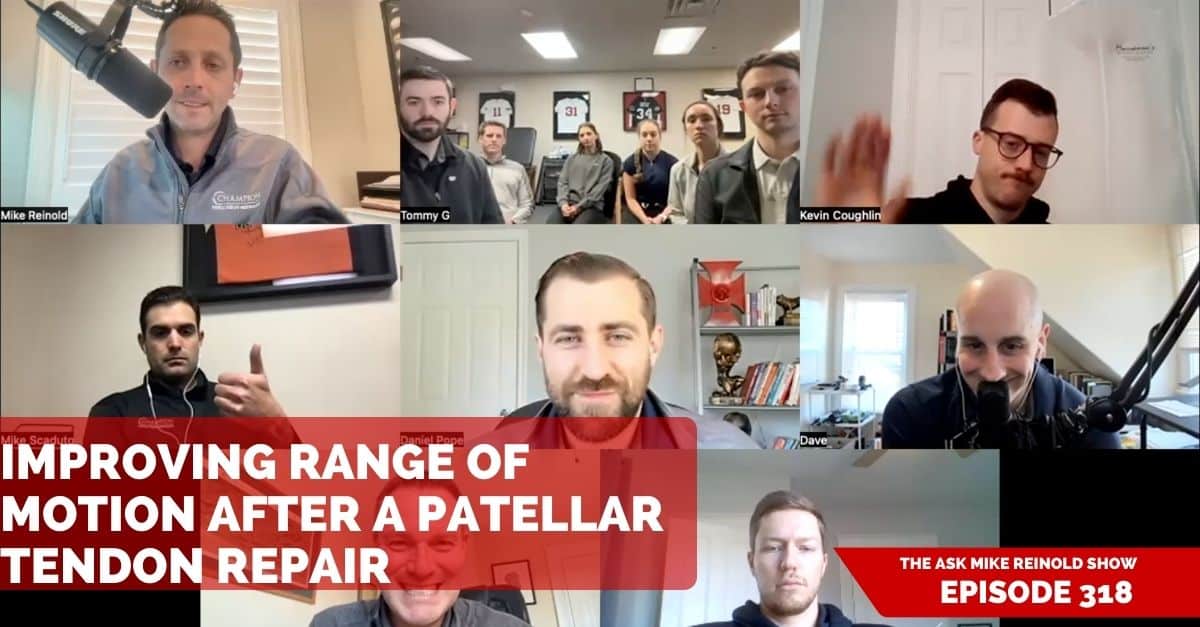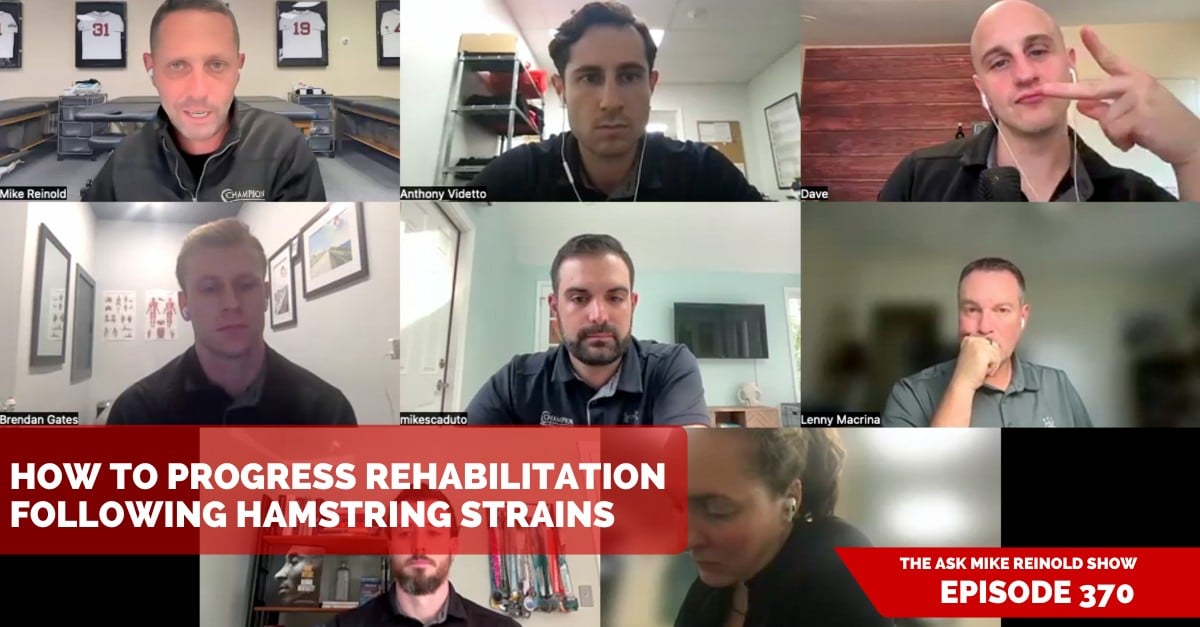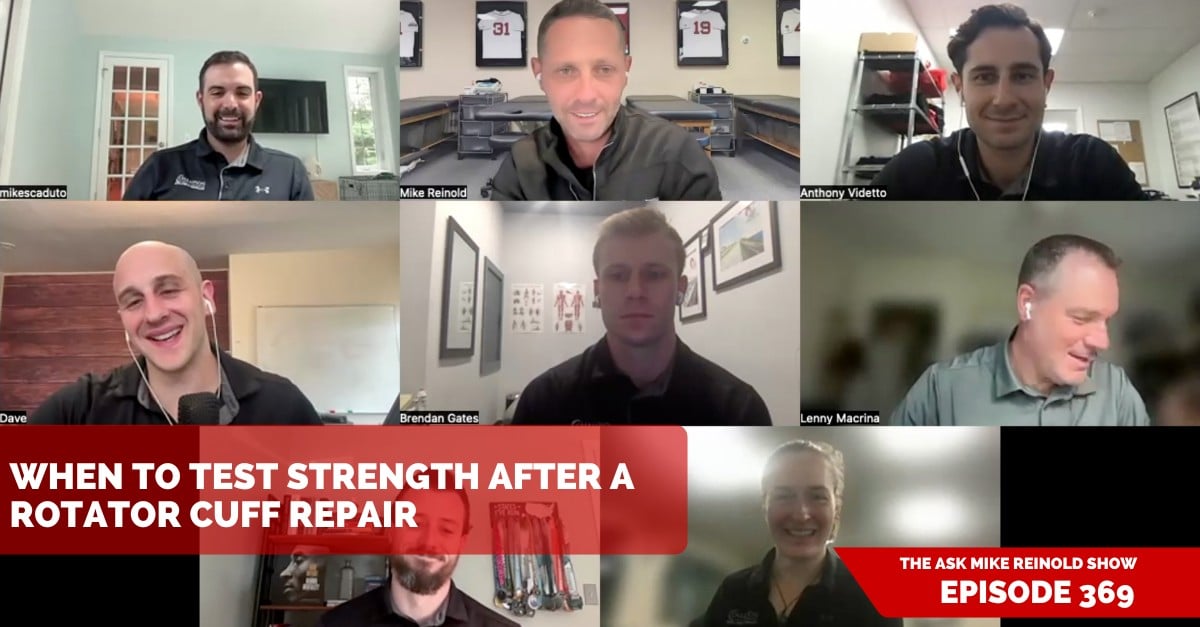Any surgery that involves repairing a torn tendon will have the potential to have complications. Most commonly, this involves a loss of motion.
Depending on the activity, some discomfort is expected. But you also don’t want to overload the healing tissue.
To view more episodes, subscribe, and ask your questions, go to mikereinold.com/askmikereinold.
#AskMikeReinold Episode 318: Improving Range of Motion After a Patellar Tendon Repair
Listen and Subscribe to Podcast
You can use the player below to listen to the podcast or subscribe. If you are enjoying the podcast, PLEASE click here to leave us a review in iTunes, it will really mean a lot to us. THANKS!
Transcript
Corey:
Yeah, so Dan from Kentucky asked, “What are some strategies to regain deep knee flexion past 90 degrees after patellar tendon repair, especially when the athlete reports high amounts of pain or discomfort?”
Mike Reinold:
That’s a good one. And I got to always admit, when we have these big tendon repairs, even I get a little anxious when they’re coming back, especially when they start doing a lot of new things like running, jumping, that sort of thing.
Dave Tilley:
The first jump of every Achilles repair I treat, I’m like, ah, I know it’s fine, but I’m still nervous.
Mike Reinold:
I don’t know it’s fine. You’re just like, man, I can’t believe that held up. The surgery’s amazing.
Dave Tilley:
There’s no literature on it too. No literature on what to start or where to do, and you’re like, all right, let’s see how this goes.
Mike Reinold:
Yeah, we’ll just go slow and gradually. Any muscle tendon repair still just gives me anxiety as they return, but it goes back down to that slow gradual progression that we always talk about, and as long as you’re doing that, I think you’re going to be okay with that gradual application of load. I like this question about range of motion because I do think that is something early career professionals get stuck on sometimes and they get nervous with range of motion. Let’s start with that. Maybe I might even ask Len this too. You’ve probably seen the most of these people on the call, but how common is it to have discomfort after a patellar tendon or a quad tendon repair with range of motion? Is that normal?
Lenny Macrina:
Yeah, I mean it’s very normal. So then you get to assess why. What are we doing? Are we trying to progress them too early? What was their motion before the surgery? Hopefully normal and they had an acute fall and tore whatever tendon it was, but I think it’s normal and you got to just assess, are we trying to progress too fast and we trying to do something that they’re just, their body is just not ready, which means you have to go back to your basics of: do they have good baseline strength, do they have the passive motion to get there, and do they have the relative symmetry to squat to 90, nevermind below 90, and then assess if you had force plates and all that. What’s their concentric, what are the eccentric forces, and are they still favoring one side?
But I think it’s normal and I think you just maybe get to back off a little and work on the basics, more of the basics of getting patella moving, getting soft tissue, make sure that’s feeling good and not irritable because they’re probably tight. The whole knee is probably still tight. You see that a lot with these, they scar down, the patella doesn’t move as well. Just all the tissue around the kneecap is… It’s kind of bogged down and maybe the quad’s not stretching well and the quad muscle is just not moving well. And you have all that you can work on through soft tissue stuff and patella moves and then a lot of motion, on a bike, and then slowly getting them to drop down into more degrees of flexion.
Mike Reinold:
You know, that’s interesting how… I think we both heard that question and I was thinking they were talking about passive range of motion on the table, but I kind of like what you thought there, Len, that maybe they are talking about functional movements. I think you’re actually right. I didn’t even think of it that way. So that’s actually a really good point here.
Lenny Macrina:
I mean if they only have 90 on the table, but either… that’s not normal. But, yeah …
Mike Reinold:
I was thinking, yeah, no, I think you’re right. And I think you’re reading that question right. For me, it’s all about that gradual application at load. I like that, but Mike, did you want to jump in?
Mike Scaduto:
Well, my point was going to be about restoring passive range of motion on the table and just playing with the position that the patient’s in. So if you’re doing a supine or even a prone knee flexion or quad stretch, I could see how maybe that would cause some more irritation at the patella insertion there… Patellar tendon insertion. So maybe a classic Lenny… When he’s seated off the edge of the table, make sure they’re nailing that first and if they can get past 90 in certain positions, but some positions are more painful, it’s just something to play with and tweak.
Mike Reinold:
That’s a good one because when you’re on your stomach doing passive range of motion, right, you’re tensioning the quad from both ends, right? So if you sit up, that takes a little tension off proximal. I think that’s pretty helpful. Right. Dan, what do you think?
Dan Pope:
Yeah, I think this is a kind of a weird thing with the quad tendon, but in deeper degrees of knee flexion, quad tendon actually starts to kind of share a little bit of the surface area available for the patella femoral joint. So I think at the very end ranges of motion, let’s say a deep squat, there are two things going on. So the deeper you’re going through the squat, the more generally the quad and the knee has to work, so there’s going to be more stress through that whole mechanism, puts more tension on the tendon, plus that tendon is potentially wrapping around in the trochlear groove, kind of acting kind of like the patellar femoral joint a little bit. So it just, the tendon takes a lot of stress and deep ranges of flexion. So to echo everyone’s point, get the passive range of motion back, but if your tendon is not handling these forces well then you probably just want to have a really good set of exercises where you can start to load those end ranges of motion.
So maybe that’s like a TRX assisted squat where you go into full range, where you’re trying to utilize the entire joint and put some stress through that tendon in a way that’s not that stressful first and then work your way up over the course of time. Yeah, I think what does happen is that a deep squat is just freaking hard on the knee, so it’s the end range of motion. It’s just hard on that knee. You have to have a library or catalog of exercise you can use to train that position prior to sending someone off into the bottom of a squat. It makes sense that it still hurts.
Mike Reinold:
And if you’re trying to do past 90 degrees in a functional movement like a squat or something like that, and they’re having a decent amount of pain and discomfort, then definitely, that’s not something you want to do. We talk a lot about pain. We’ve talked about that in a few episodes ago, pain with exercises here, but when you’re talking about a tendon repair and you have pain at the tendon repair with an exercise, that’s not one of those things you work through, right? That’s not a little bit, that is, are you putting too much tension on the structural integrity of the repair? That would be really bad, right? So I think that makes sense, and they have to have the passive range of motion. Then you have to slowly progress loading through shallow to deeper ranges of motion and light to moderate to heavy load. That makes sense. Just in case Dan’s asking it from this perspective, let, let’s jump back and go back to Lenny on this. Lenny, two weeks after a patellar tendon repair, you’re doing passive range of motion on their knee. Is that ever pain free?
Lenny Macrina:
Right? No. No, it’s usually not. That’s if the doctors are allowing you to do that at this point.
Mike Reinold:
Good point.
Lenny Macrina:
We’ve backed off everything, everything so much that they get really stiff. Because they want the tendon to get stiff, right? It’s just like a cup that they’re slowing down rehab, unfortunately, but no, they’re going to be painful. So it’s slowly building capacity in that tissue, meaning slowly getting the motion back, slowly getting the patella tendon, the patella to move, even the patella tendon has tissue around it. It has to be mobile and if everything’s kind of wadded down, and scarred down, you’re going to get pain in that area. It’s just that things have to move in order for the leg to need to go into flexion and especially in a weight-bearing position too, if that’s what we’re talking about. So it’s going to be painful. Slowly work through it, not too much pain, especially if they’re weight-bearing. And then these things take weeks if not months, longer than our insurance companies are giving us for visits, unfortunately. You’ve got to disperse those visits appropriately. Right?
Mike Reinold:
I think that brings up a good point here too, because let’s say somebody has 7/10 pain and that is during their, I don’t know, three, four months down the road and you’re trying to do a deep goblet squat for the first time or something like that, and they have 7/10 pain. Okay, now let’s say they have 7/10 pain, and it’s week two and you’re just letting gravity take their knee down into about 30, 40 degrees. To me, I think those two are different because I know that the stress on the tendon during my passive range of motion, especially that gentle, is not stressful enough to hurt the repair. I just know that because that is not a stressful movement. So if they have discomfort, I mean that has a lot to do with the surgical procedure, them recovering from the trauma, that sort of thing.
That’s the sort of thing I’d be like, look, if we don’t do this, you’re going to get stuck and that’s going to be way more painful. It’s going to be way harder to get through. I think as a clinician, you also have to think about, is the activity I’m doing, what’s the inherent stress applied to the tissue with the activity I’m doing? Is there pain, and does it make sense? So pain with a deep squat three months down the road I think is a lot different from pain when you’re just doing some gentle range of motion. I’d be a little bit more susceptible to work through a little bit of pain. Now notice I said “let gravity take the knee down”, not I’m pushing and forcing it. Now you could argue that’s too much stress, right? Now I’m putting stress on it, but just a little bit of gravity there. I think this is where you have to start using some clinical judgment, right?
So I would say think about that with the activity. Is the activity I’m asking them to do really that stressful that it should be causing this pain or is this just more from the trauma of the procedure, and something that we should work through? As you get later and you start doing it with exercises and you’re having pain during the exercise, that’s probably bad. And I think that’s a good way of thinking of it. So awesome. Great question, Dan. Hopefully that helped. If you have a question like that, head to mikereinold.com. Click on that podcast link and you can fill out the form to ask us questions. And please head to Apple, Spotify, subscribe so you can keep getting notifications when we have a new episode. Thank you so much.





